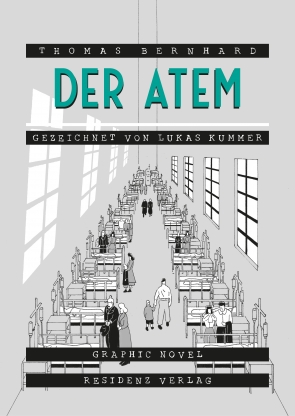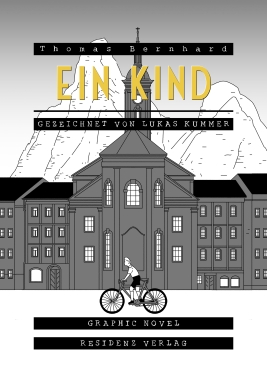Mit seiner geradlinigen, geradezu strengen grafischen Umsetzung trifft er nicht nur den Ton, sondern fügt mit visuellen Mitteln eine neue, äußerst stimmige Ebene hinzu.
[Quelle: Krichmayr, COMIC]
Schwarz, weiß, grau, grauer, dunkelgrau... Wer möchte schon in den Kopf von Thomas Bernhard kriechen, diesem konsequentesten und sensibelsten aller Hassbegabten. Lukas Kummer hat es furchtlos getan.
[Quelle: SÜDDEUTSCHE ZEITUNG]
„Der Atem“ ist eine gelungene Mischung von Text und Bild, zudem eine Fundgrube von Formulierungen, die man so schnell nicht wieder vergisst.
[Quelle: MONA LISA BLOG]
Der Innsbrucker Illustrator Lukas Kummer hat Thomas Bernhards Erzählung „Der Atem. Eine Entscheidung“ kongenial bebildert.
[Quelle: Karin Cerny, PROFIL]
Gestützt auf einen düsteren Realismus und repetitive grafische Elemente, die die Wirkung von Bernhards bohrender Sprache, seiner endlosen Suada, Satz für Satz großartig zur Geltung bringen.
[Quelle: Judith Leister, LITERATURHAUS WIEN]
Und erneut ist dem Illustrator und Autor eine intensive und eindrückliche Umsetzung der Vorlage gelungen, die Leser_innen in einen rauschhaften Bann zieht.
[Quelle: Sven Biller, I-LOVE-URBANART]
Die sprachlichen Stilmittel Thomas Bernhards – Übertreibung und Wiederholung – bringt Kummer dabei zeichnerisch zur Geltung.
[Quelle: Brigitte Egger, DOLOMITENSTADT.AT]
Auch „Nicht-Bernhardianer“ bekommen eine gute Vorstellung von der immensen Sogwirkung dieser Prosa.
[Quelle: Oliver Herzig, XING]
Schlichte, aber markante Schwarz-Weiß-Zeichnungen erzählen die persönlichen Geschichten Thomas Bernhards aus dessen oft schwieriger Kindheit und Jugend in eindringlichen Bildern ohne überflüssiges Beiwerk.
[Quelle: RED, OOE.ORF.AT]
Die abweisende Spitals-Architektur, das im Umgang mit dem Tod fatalistisch und routiniert agierende Pflegepersonal, die Gestalt des Großvaters, der den Enkel zum Durchhalten motiviert und schließlich selbst stirbt, die in körperlichen Krisen unscharf werdende Außenwahrnehmung - all' das findet sich in den beeindruckenden schwarz-weißen Zeichnungen, die dennoch Thomas Bernhards Text Raum lassen.
[Quelle: Wolfgang Huber-Lang, APA]
Mit klarem Strich gelingt es Kummer abermals, dieses finstre und helle Kapitel aus Bernhards Leben festzuhalten. Das Buch ist ganz große Kunst, Kummer zeigt sich auf der Höhe der Bernhardbewältigung und schafft ein bleibendes Werk, Hut ab!
[Quelle: Frank Willmann, kulturexpresso]
Kummer meistert die Transformation des literarischen Ausgangstextes hin zu einer graphischen Ausdrucksweise mit viel Fingerspitzengefühl und wird damit den Eigenheiten und Besonderheiten des Bernhard’schen Schreibens erneut gerecht.
[Quelle: Wolfgang Praßl, LILIT]
Die Kritik feierte »Die Ursache« und »Der Keller« geradezu hymnisch. Ebenso gelungen ist dieser Band ...
[Quelle: Claudia Gerdes, PAGE]
Thomas Bernhards Sprache ist kantig, von Wiederholung und Variation durchdrungen, dabei sehr präzise: Kummer hat daher einen sehr klaren, kühlen Zeichenstil gewählt. Die häufige Wiederholung nur leicht modifizierter Panels entspricht exakt dem sprachlichen System Bernhards. Was beim oberflächlichen Durchblättern langweilig oder eintönig erscheinen könnte, entfaltet beim Lesen hingegen eine große Intensität und Sogkraft, der man sich nicht entziehen kann.
[Quelle: Christian Meyer-Pröbstl, STRAPAZIN]
Der (...) Illustrator gibt mit einfachen Schwarz-Weiß-Zeichnungen eindrücklich die Eintönigkeit der langen Krankenhausaufenthalte und die deprimierte Grundstimmung der Hauptfigur wieder. (...) Ein beeindruckender Band, der sich wohl auch für eine Krankenhausbibliothek eignet. Empfohlen.
[Quelle: Peter Bräunlein, EVANGELISCHEN BUCHBERATER]
Lukas Kummer (...) stellt in dieser Graphic Novel die Trostlosigkeit in den Vordergrund. (...) Alles, was geschieht, geschieht trostlos.
[Quelle: GRAPHISCHE KUNST]
Das Wechselspiel von Wortfetzen und (grauen) Farbklecksen läuft hier zu einer Hochform des Comicmediums auf.
[Quelle: Martin Reiterer, WIENER ZEITUNG]
Eine meisterhafte Graphic Novel über das Leben als Akt des Willens und eine menschenverachtende Krankenpflege, in der jeder sich allein zur Genesung kämpfen muss. Durch die Coronapandemie haben diese Bilder von massenhaft Kranken und Toten eine neue Aktualität bekommen. Ein empfehlenswertes Buch zum Tiefdurchatmen!
[Quelle: Anka Willamowius, BUCH-LADY.DE]



















